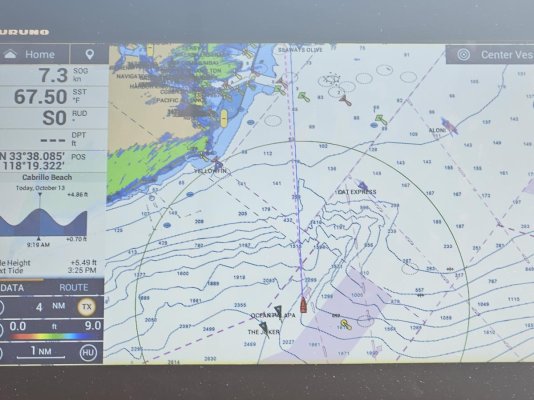Excellent question Benthic2. As you say the type of boating has a bearing on instrument choices. I think personal experience also has a bearing on the choices. For example I am very experienced using radar so place a higher priority on that than many recreational boaters. In retirement we are now fair weather, mostly daylight boaters from Wa State ranging north into BC and Ak. This area has different requirements as you move north, some heavily traveled by recreational and large commercial vessels, some places you hardly see another boat. Some areas very settled with help and support nearby, some remote where help and support could be a bit of a wait.
If I were outfitting from scratch:
#1 VHF, multiple. Good comms are too important to not have redundancy. Plus in areas with heavy commercial traffic I want to monitor multiple channels without scanning. 16, 13 and the appropriate VTS channel.
#2 Hand held VHF. For numerous reasons. As an additional VHF to meet my above requirement. For use in the dingy, both excursions and abandon ship.
#3 Dingy / motor. For excursions as well as abandon ship.
For my $$$ 1,2 and 3 are all required. I could lump all together and call them #1. I wouldn't venture beyond the San Juans without all 3.
#4 EPIRB. Still the best ‘yell for help’ device for a full on emergency.
#5 / #6 Radar / Autopilot. It’s a toss up here. At this point the costs are starting to pile up in my imaginary outfitting from scratch. Radar can do more that see through the fog. Collision avoidance, even without AIS, MARPA and the like. Simple old skool piloting by with range and bearing in any weather. Autopilot. It’s more than a convenience. It frees me up to pay more attention to what’s going on around me. If at this point in my outfitting I could afford just one then that choice would affect how I boat. For example without radar there would be a lot of days on the hook waiting for the fog to lift.
# 7 Crash pump, maybe. Good bilge pumps without doubt. I do pack a 110 Volt sump pump that with a generator and or inverter can be pressed into service should the bilge pumps not be able to keep up.
Not needed for the area / way we boat are
Night Vision
Stabilized binoculars
Air conditioning. We need heating more often.
Interesting that you don’t have a sounder, chart plotter + GPS or AIS on your list.
As a comment unrelated to your question. I prefer as much as real estate allows stand alone devices over MFD all in one devices. I want separate screens with separate functions, networking is OK but there are times I don't want overlays or small split screens. Plus if one goes down the others still work. I don't want devices that are touch screen only. When things get sporty or when my fingers are wet I want knobs and buttons.
I don't think anyone has discussed that the value of AIS depends on the type of boating you do. Do you have to go out in bad weather, at night, in tricky areas ? If yes, AIS is probably very valuable. If you have the luxury of not going out on bad days, avoiding high traffic areas and just being the average boater, it is probably less valuable.
Another discussion point that would have been useful is a ranking of electronics priority. If your boat didn't have AIS or an autopilot, which would you get first. How about RADAR vs AIS ....AIS vs Epirb. ( I am not suggesting these are competing devices, just trying to see which people think is more important ) Sure its easy to say "AIS is great. You should get it" but some people have a budget and may not be able to get all the gadgets they want right away. Sure it's only $600, but everyone here is fully aware of all the expected and unexpected expenses that come from just maintaining a boat, never mind trying to upgrade one.
As far as mandating AIS, I don't see that happening ever. Boaters are a small percent of the population, and cruisers are a small percentage of the boating world. There are probably 100 trailer launched bowriders for every 1 cruising trawler. For most of the boating world, I think "going boating" means you launch, go to the sandbar for a few hours and go home....or you go to the local restaurant with a dock.
In New England most people only boat between Memorial Day and Labor Day and only on weekends. That means there are really only about 30 potential boating days per year for the casual recreational boater. $600 for something that you are currently doing without and probably don't need, is a hard expense to justify for the average boater.
If anyone is still following this, I'd love to see what order you would install the following
VHF
Handheld VHF
Autopilot
Radar
Epirb
Night Vision
Stabilized Binoculars
Dingy w/ Motor
Crash pump
Air Conditioning.
Thanks



